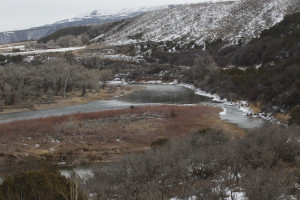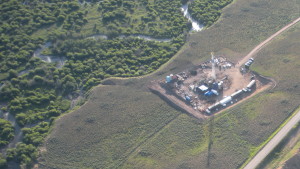We have much more to do and your continued support is needed now more than ever.
Water and Wildlife Shouldn’t Mix with Oil and Gas

“It’s possible we may have dodged a bullet this time, but this should be seen as a wake-up call.”
That’s the reaction of National Wildlife Federation attorney Michael Saul to an ongoing, underground leak of what’s variously been described as oil, an oil-like substance or a mix of hydrocarbons.
The leak, or seepage, measures 200 by 170 feet and is near a natural-gas processing plant in western Colorado. The seep is just 60 feet from Parachute Creek, which flows into the Colorado River.
The source and cause of the leak are unclear. It’s not even clear exactly what is spreading underground. Workers from Williams, which owns the gas plant and pipelines in the area, discovered the leak during excavation work March 8.
The Colorado Department of Natural Resources says about 5,900 gallons of oil and more than 100,000 gallons of water had been recovered by Wednesday morning. Crews are digging up a large-diameter gas pipeline.
State and federal environmental agencies say so far, no contamination has reached the creek.
Still Waiting
That’s the good news. The bad news is five years after Colorado regulators said they would look at establishing statewide buffers around waterways, nothing has happened.
The state Oil and Gas Conservation Commission approved 300-foot setbacks from gold-medal fisheries and waters containing native cutthroat trout as part of an overhaul of oil and gas regulations in 2008. That’s a relatively small volume in a state that is the headwaters of rivers that provide water for states across the region.
Left hanging was the issue of how far back oil and gas wells and related infrastructure should be from other riparian areas. It was supposed to be addressed by a committee representing various interests.
“We’re still waiting,” said Suzanne O’Neill, executive director of the Colorado Wildlife Federation.
The spill near the town of Parachute “is Exhibit A for the commission to begin the long-delayed work of establishing riparian setbacks,” Saul said.
Spills Happen
It’s not as if oil and gas spills are rare events in Colorado. An analysis by the Bull Moose Sportsmen’s Alliance showed energy companies reported nearly 1,000 oil and gas spills in a three-county area in western Colorado from 2001 to 2010. Garfield County is the site of the latest incident. The counties are home to some of the nation’s largest mule deer and elk herds and native cutthroat trout. Hunting, fishing, tourism and recreation are big contributors to the area’s economy.
The Denver Post reported in 2011 that oil and gas spills were occurring at a rate of seven every five days that year and had resulted in the release of more than 2 million gallons of diesel oil, drilling wastewater and chemicals that contaminated soil and water.

Required setbacks and better monitoring of surface and groundwater quality are crucial to protecting keeping Colorado waterways clean and safe for people, fish and wildlife.
“This might have been detected sooner with better monitoring. We don’t know how long this has being going on,” Saul said.






















